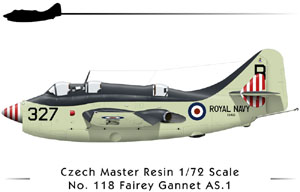Czech Master Resin's 1/72 Fairey Gannet AS.1 | | 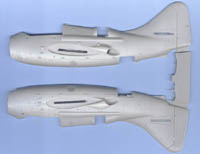 History History
The need for antisubmarine aircraft was painfully obvious during the Second World War. With the emergence of the Soviet Union as a global naval power the need became even more pressing and England quickly decided to try and fill the void. A combination of endurance and payload resulted in a need for a new type of powerplant. Armstrong Siddeley took a pair of ASM.3 Mamba engines and mounted them back to back, resulting in a very compact powerplant with high output. This engine was packed into the fuselage of the Gannet and contra-rotating propellers were fitted to the front. This resulted in excellent power for takeoff and landing, while once in the air the ability to shut down one of the engines allowed the plane to have a very long endurance. The Gannet quickly found itself in fleet service, where it performed admirably. So much so that several countries expressed interest, including at least two navies that had no ships to operate them from. The navies of Australia, Germany and Indonesia  all purchased the Gannet, putting the Fairey aircraft over just about every ocean in the world. all purchased the Gannet, putting the Fairey aircraft over just about every ocean in the world. The Kit Upon receiving this kit in the mail my first impression was that this is one heavy model! There's over 60 parts in this kit, as well as two sets of vacuformed canopies. A large decal sheet is also included, as is a set of vinyl canopy masks. The fuselage is split into right and left halves, while the stabilizers and wings are molded as solid pieces (the wings probably are the heaviest part of the kit). The kit, while labeled an AS.1, actually can be built up as an AS. Mk. 4, COD Mk. 4, T. Mk. 2 as well as the AS. Mk. 1. The instructions are very clear as to what parts are used for the different variants. 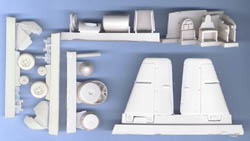 Starting with the interior, there's a very complete cockpit for both the front and rear offices. A floor, instrument panels, seats, and control sticks combined with the sidewall detail molded into the fuselage halves will result in a very nice looking interior, although like any kit a little extra detailing wouldn't hurt. Then again, there's not going to be much visible under those small canopies anyway. There's two choices of forward bulges on the front of the fuselage, depending on the variant you choose to do. The same story for the belly radome as well, with a separate cover for the trainer and COD versions, while the AS marks have a full radome assembly. Starting with the interior, there's a very complete cockpit for both the front and rear offices. A floor, instrument panels, seats, and control sticks combined with the sidewall detail molded into the fuselage halves will result in a very nice looking interior, although like any kit a little extra detailing wouldn't hurt. Then again, there's not going to be much visible under those small canopies anyway. There's two choices of forward bulges on the front of the fuselage, depending on the variant you choose to do. The same story for the belly radome as well, with a separate cover for the trainer and COD versions, while the AS marks have a full radome assembly.
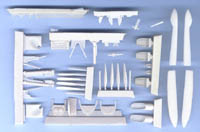 The wings and tailplanes are solid and thus heavy, but for the first time Czech Master has provided tabs for both to aid in alignment and in strength. The wheel wells in the wings are deep and detailed and the resin landing gear looks suitably strong. I've heard that Czech Master will be changing this to white metal landing gear, which will definitely hold the weight of the finished model better than the resin gear. The fuselage front end captures that ugly Gannet look quite well, with a separate fuselage piece and two spinners. All eight propeller blades are molded separately, so break out your alignment jigs for this one. Remember, the propellers are contra-rotating, so align them in opposite directions. The wings and tailplanes are solid and thus heavy, but for the first time Czech Master has provided tabs for both to aid in alignment and in strength. The wheel wells in the wings are deep and detailed and the resin landing gear looks suitably strong. I've heard that Czech Master will be changing this to white metal landing gear, which will definitely hold the weight of the finished model better than the resin gear. The fuselage front end captures that ugly Gannet look quite well, with a separate fuselage piece and two spinners. All eight propeller blades are molded separately, so break out your alignment jigs for this one. Remember, the propellers are contra-rotating, so align them in opposite directions.
The decal sheet is really stunning, with a total of seven schemes included on the roughly 5" x 7" sheet. The majority of the markings are either black or white, with the only color being the red and blue of the roundels and the red and yellow of the 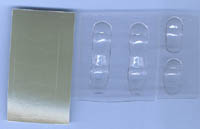 German flag. Alignment is pretty good, with the only problem area being the German flags, always a difficult decal to do. There are a total of three British, two German, one Australian and one Indonesian. The majority of the schemes presented are camouflaged in extra dark sea gray over sky. Starting with the British examples, there's an AS. Mk. 1 from 820 Squadron, flying off of HMS Bulwark in 1956/57. The second British example is overall blue and is a COD Mk. 4 flying off of HMS Ark Royal from 1964 to 1966. The third British example is a T. Mk. 2, painted overall aluminum with yellow stripes on the fuselage and wings. This plane flew out of RNAS Ford in 1958. German flag. Alignment is pretty good, with the only problem area being the German flags, always a difficult decal to do. There are a total of three British, two German, one Australian and one Indonesian. The majority of the schemes presented are camouflaged in extra dark sea gray over sky. Starting with the British examples, there's an AS. Mk. 1 from 820 Squadron, flying off of HMS Bulwark in 1956/57. The second British example is overall blue and is a COD Mk. 4 flying off of HMS Ark Royal from 1964 to 1966. The third British example is a T. Mk. 2, painted overall aluminum with yellow stripes on the fuselage and wings. This plane flew out of RNAS Ford in 1958. For the foreign operators, the German planes are both AS. Mk. 4s from MFG 3, one coded UA+106 and the other UA+114. Interestingly, UA+106 has British roundels on the lower wing. 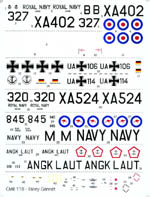 The Australian example is an AS. Mk. 1 from 816 Squadron, HMAS Melbourne, in 1960. The Indonesian example is an AS. Mk. 4 from early 1962. All of the foreign examples are finished in the extra dark sea gray over sky. The Australian example is an AS. Mk. 1 from 816 Squadron, HMAS Melbourne, in 1960. The Indonesian example is an AS. Mk. 4 from early 1962. All of the foreign examples are finished in the extra dark sea gray over sky. Conclusion Considering the competition for 1/72 Gannets this kit easily comes to the top of the heap. If you want to build a Gannet in 1/72 this is the kit to get. You'll have a bit of work to do to get it cleaned up, but it is light years ahead of the old Frog kit. The large decal sheet offers something for everyone, so there's no excuse not to get one. | 

 




|
